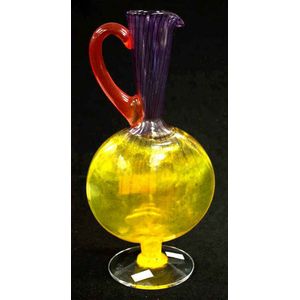Kosta Boda Bonbon Ewer by Kjell Engman (Signed)
Kosta Boda signed bonbon ewer / pitcher by Kjell Engman, signed to base, number 88065. 27 cm high.
You must be a subscriber, and be logged in to view price and dealer details.
Subscribe Now to view actual auction price for this item
When you subscribe, you have the option of setting the currency in which to display prices to $Au, $US, $NZ or Stg.
This item has been sold, and the description, image and price are for reference purposes only.
- Ewer / Pitcher - A type of jug with a narrow neck bulbous body and wide spout, originally used for carrying and storing liquids such as water or wine. In medieval times they were the source of water to wash ones hands during and after a meal. later the shape was used for vessels in silver, gold, glass and ceramics.
In Victorian times they were made in ceramics and occasionally glass with a matching basin, and sometimes other accessories such as a soap holder or toothbrush holder. Their purpose was to provide facilities for personal washing In the early 19th century were often enclosed in purpose built stands, and later resided on a washstand..
Sometimes the words "ewer" and "pitcher" are used interchangably, but a pitcher is generally considered to be a jug, and would have a wide mouth, and a gently tapering body. - Bonbon Dish - A bonbon dish is a type of serving dish that is specifically designed to hold small, bite-sized candy or chocolates, which in the 19th century were also known as bonbons. They were often used for special occasions, like parties, weddings and holidays. They are also a common serving piece for after-dinner desserts, such as chocolates.
These dishes are often decorative and can be made from a variety of materials such as silver, glass, crystal, metal, or porcelain. Bonbon dishes come in many different shapes and sizes, but most are relatively small, and have a shallow bowl or dish shape.
This item has been included into following indexes:
